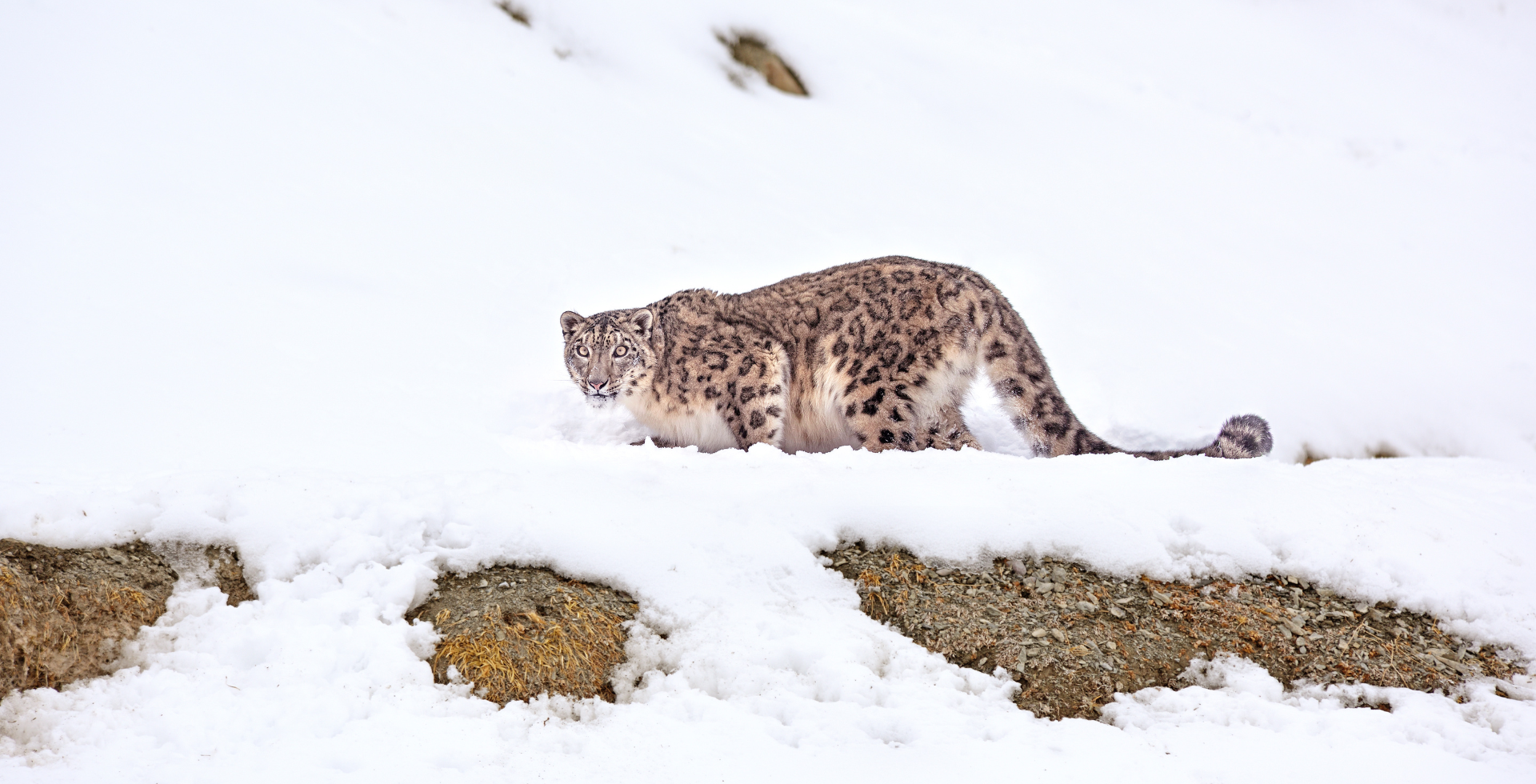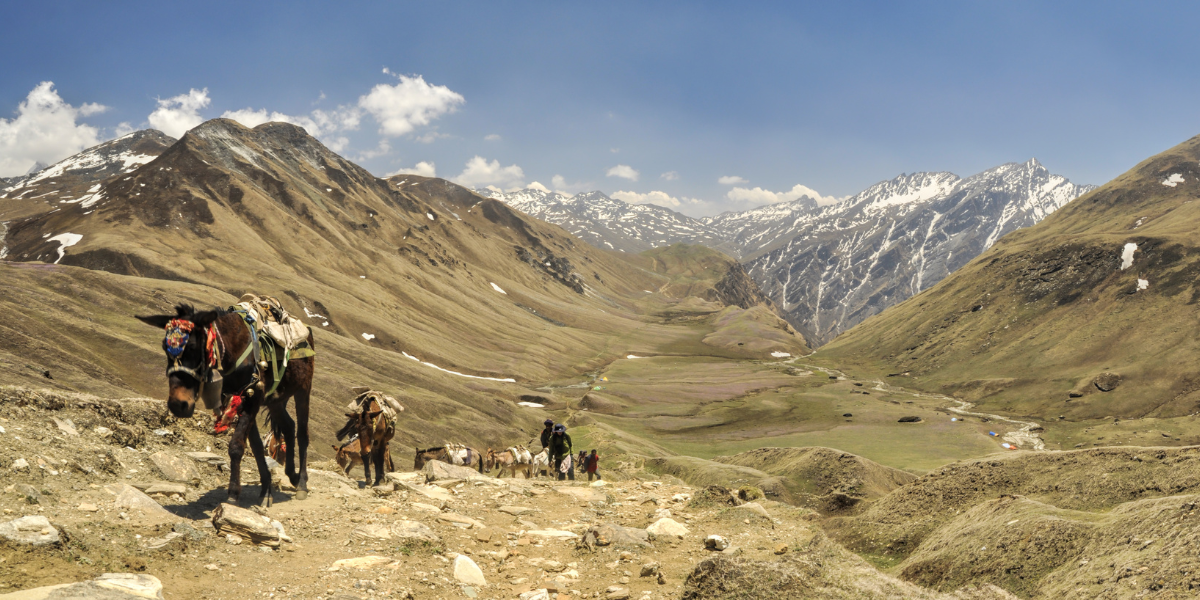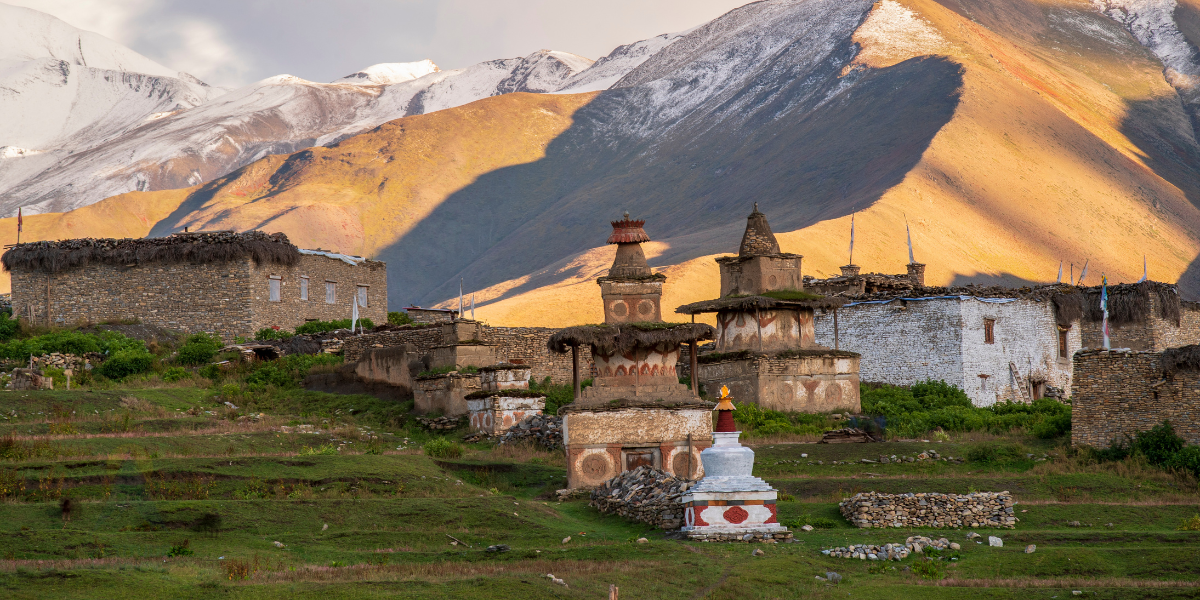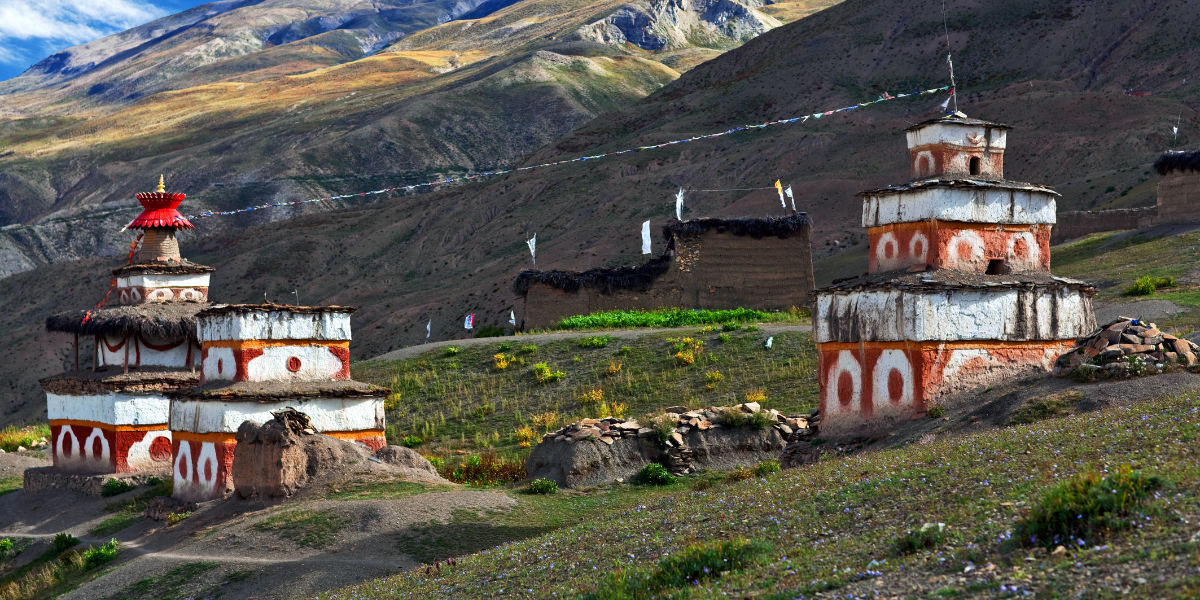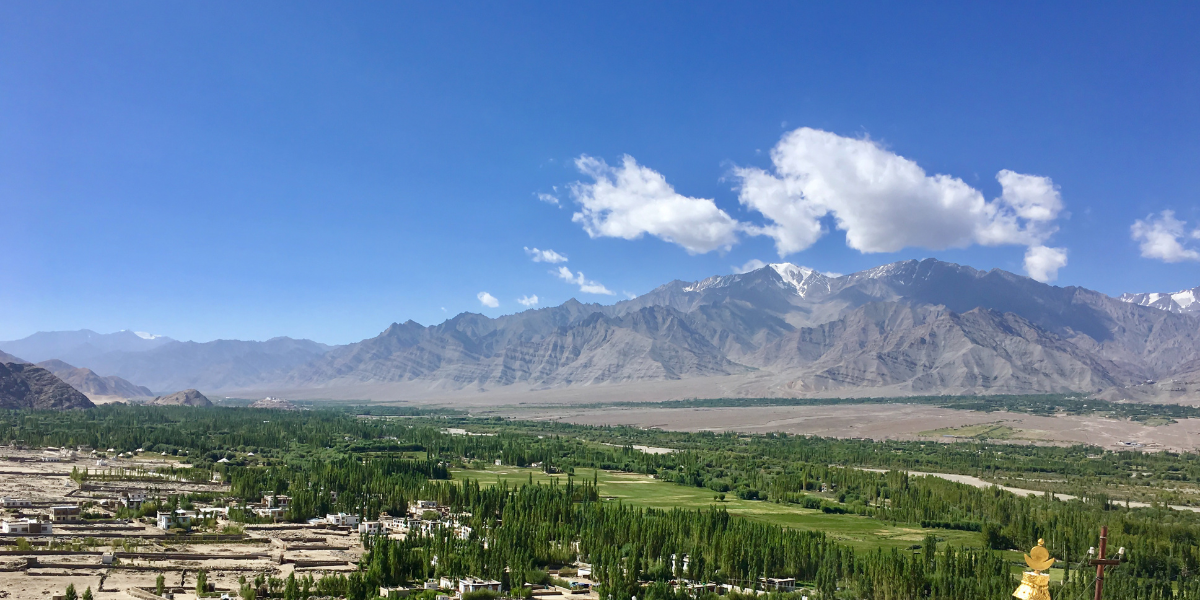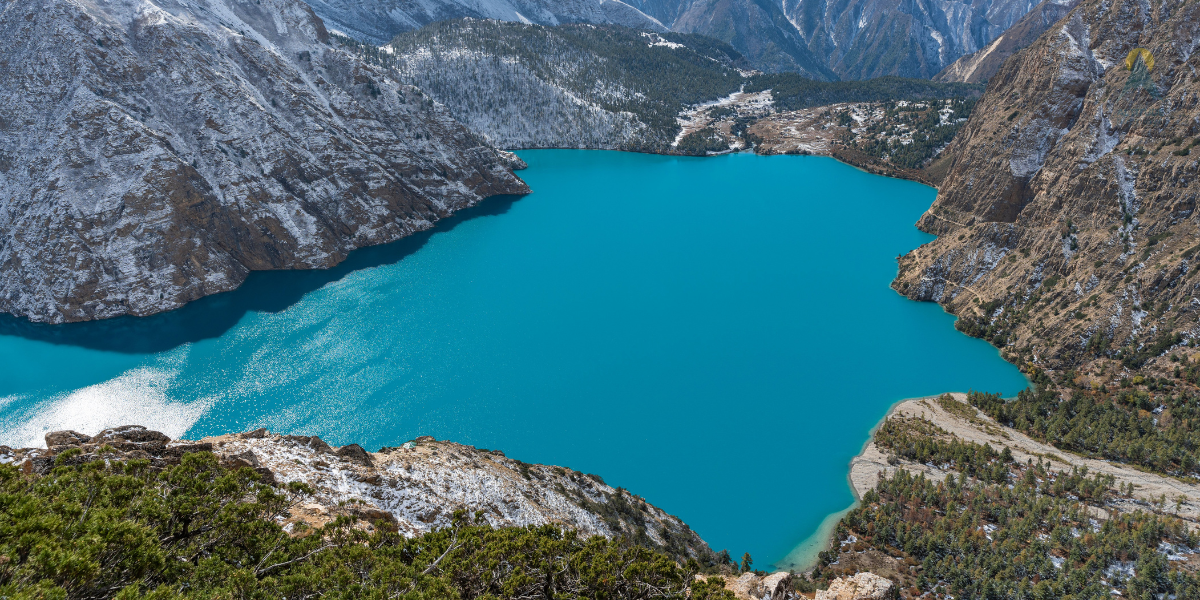Dolpo is an isolated paradise in the northwestern part of Nepal in Karnali province. It is one of the biggest and most remote regions of Nepal, with very few human settlements. There aren't as many human settlements in the Dolpo as there are in the larger region, but there are a few traditional and ancient villages where you may experience rich culture and traditions that distinguish the Dolpo apart from other parts of Nepal. These villages provide you with an insight into ancient Bon-Po culture that you’ll hardly find anywhere else. Surrounded by fascinating landscapes, from high mountain passes to seasonal vegetation such as buckwheat, it adds to the village’s charm even more.
The villages in Dolpo have distinctive characters, making them stand out in the highly deserted area. The houses are mostly made of natural materials using local resources such as rocks, stones, mud, and cow/yak dunks with a flat roof of clay saplings pilled on top with brushwood. Homes here mostly have a prayer room inside the house, also known as a temple room, and outside the house is bounded by a large courtyard for the animals. Throughout your trek to the Upper or Lower Dolpo circuit, you will get to see these types of houses in major villages such as Ringmo, Dho Tarap, Saldang, Tinje, Chharka Bhot, Komas, and others. These villages are located in magnificent valleys surrounded by breathtaking mountain passes and serene rivers.
Dolpo Villages
There are numerous small and slightly larger villages scattered throughout the Dolpo region. Despite scattered locations, these villages share the same beauty and traditions passed down from generations. These villages are home to Dolpo’s small population and some of the few indigenous groups. All the villages listed in the table are situated among the high mountain passes, isolated from modern cities. This seclusion has allowed them to preserve their culture and keep their traditions alive to this day. Situated above 3000 m above sea level, these regions feature selective vegetation. However, the harsh climate contributes to their otherworldly beauty, making the journey to these remote places even more rewarding. The following villages were once the headquarters or major hubs in the region for trade and essential services, including healthcare and communication. These villages are significant for being the most populated in the area and have gained popularity among visitors due to their breathtaking beauty and the warm hospitality of the locals.
List of some Villages in Dolpo
Dolpo houses are isolated and some of the high-altitude settlements in Nepal and the whole world. These villages are scattered throughout the Dolpo region, which provides unique cultural exposure that will leave you in awe and pure bliss.
|
Traditional Villages |
Elevation |
|
Ringmo |
3,641 meters/11,942 feet |
|
Dho |
4,067 meters/13,343 feet |
|
Saldang |
3,856 meters/12,651 feet |
|
Musigaon |
4,230 meters/13,878 feet |
|
Khanigaon |
2,950 meters/9,678 feet |
|
Chhepka |
2,670 meters/8,760 feet |
|
Bhijer |
3,850 meters/12,631 feet |
|
Shimengaon |
3,935 meters/ 12,910 feet |
|
Tinjegaon |
4,200 meters/13,780 feet |
|
Tokyu |
4,190 meters/13,747 feet |
|
Chharka Bhot |
4,320 meters/14,173 feet |
Ringmo - The Lakeside Village
Ringmo, locally known as ''Tsho-wa,’’ which means lakeside village in the Tibetan language, is one of the hidden gems of Nepal. This traditional Bon village is located right beside the spectacular Phoksundo Lake with its vibrant turquoise color, giving it its local name, lakeside village. Located at an elevation of 3,660 metres in the lower Dolpo region, the village is surrounded by thick alpine forest. It is best known as the living museum, showcasing the ancient ways of living in the Highlands. Besides its natural beauty, one can witness its culture, as the locals have preserved the ancient culture and traditions here by tirelessly practicing their beautiful customs and traditions, keeping them alive.
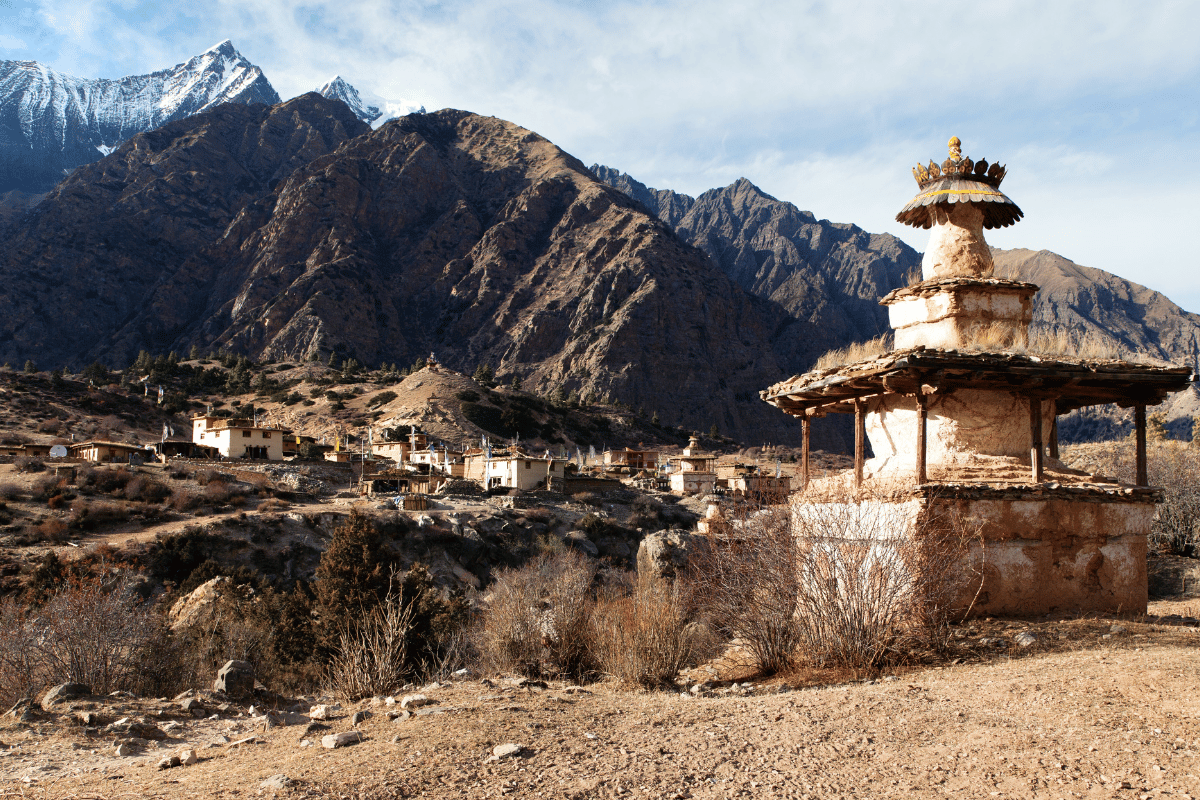
The village offers a mesmerizing view of the majestic lake along with serene natural beauty. Inside the village, there is an ancient Bon monastery called Thasung Tsholing Gompa. It comes from the Tibetan words ‘’Tha,’’ which means ‘’surrounding,’’ and ‘’Sung’’ meaning ‘’conservation’’ or ’’preservation’’. This religious landmark was built to protect the local flora and fauna, making Ringmo one of the most precious villages in the Dolpo region. It is one of the few villages that are commercialized and provides facilities such as accommodation, food, and other travel facilities for travelers. Here one can soak in the surreal beauty of nature while witnessing the day-to-day life of the locals. It is one of the first villages one will come across while accessing the Dolpo area from Juphal.
Dho Tarap - The Heart of Dolpo
Dho Tarap is another beautiful village located among high mountain passes like many other villages in the Dolpo region. The settlements of "Dho" and "Tokyu" are combined to form the new village known as Dho Tarap. The elevation of the location is 4,067 meters above sea level, making it one of the highest human settlements in the world. Dho Tarap, often called Dho, is one of the largest villages in the Dolpo region and once was a major trading hub in the area. The village is located inside the valley, surrounded by high mountain passes around the peaceful settlement, creating a gorgeous backdrop. The village is surrounded by seasonal vegetation such as wheat, potatoes, and celestial barley crops, displaying a surreal scene.
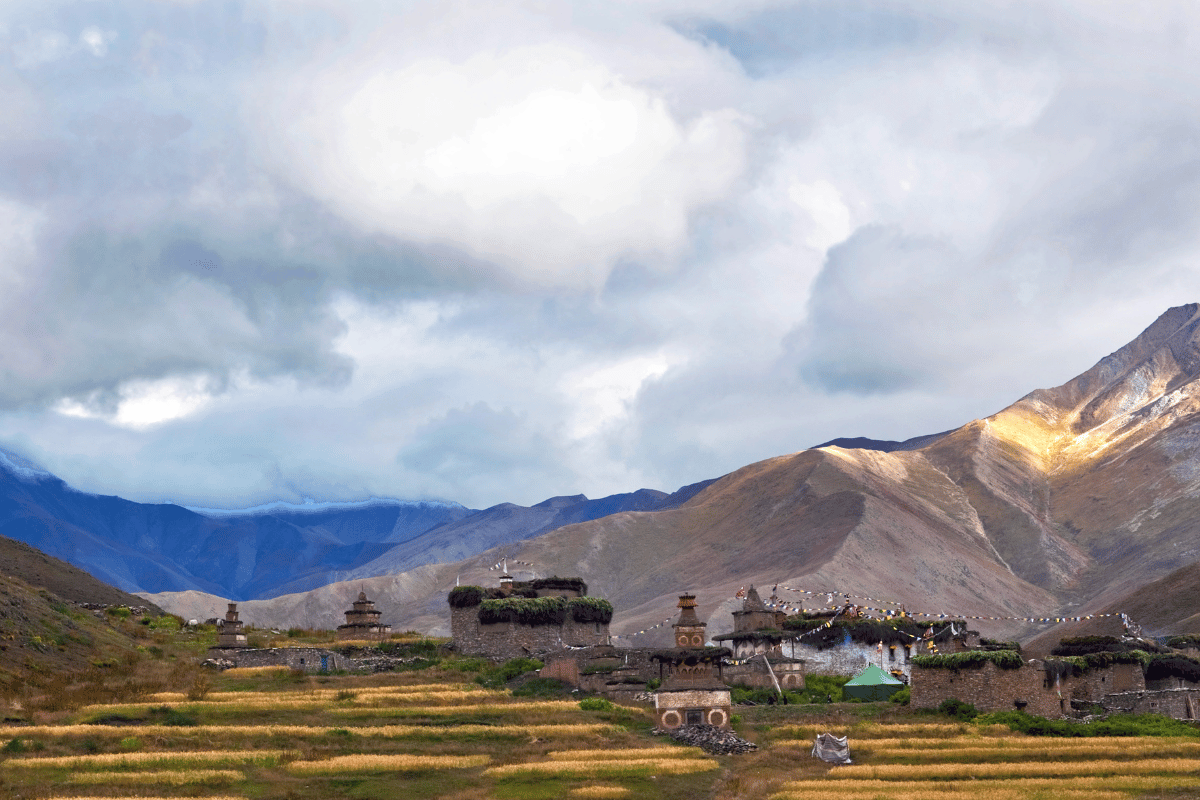
The ancient village displays traditional houses and religious landmarks such as Mani walls and gompas featuring religious murals and sculptures of their beloved deities and lamas. The landmarks between the verdant crops, such as mani walls and small gompas, add to the wonderful experience of walking the trail to the hamlet. The village showcases its historic residences, which are instantly recognizable and distinctive because of their spacious animal courtyards and all-natural construction. Most of the houses are made with local materials such as stones, mud, and wood, as they were built ages ago. Tibetan influence can be seen in the interior design of the homes as well as in some exterior elements. They have a roof coated in mud, sparse wood deposits, and prayer flags dancing in the air, spreading peace. These houses are not just aesthetically pleasing but also provide strong protection against harsh weather and strong winds. They keep the interior warm and cozy, making them well-suited for the cold conditions at high altitudes and harsh winter.
Saldang - The Cultural Hub
Another significant Dolpo settlement is Saldang, which is located in the upper Dolpo region at an elevation of 3,770 meters above sea level. It is situated quite near the Tibetan borders, where one can explore the cold, deserted landscape along with surreal high mountain passes that add to the village’s beauty. As majestic as it sounds, reaching this place requires physical and mental fitness, as it is situated behind a mountain pass on hard terrain at an impressive elevation of 3,856 m above sea level. Here in the village, you can get to see the deep-rooted culture of a stunning landscape that looks out of the world. Saldang is also the turning point of the Dho Tarap valley.
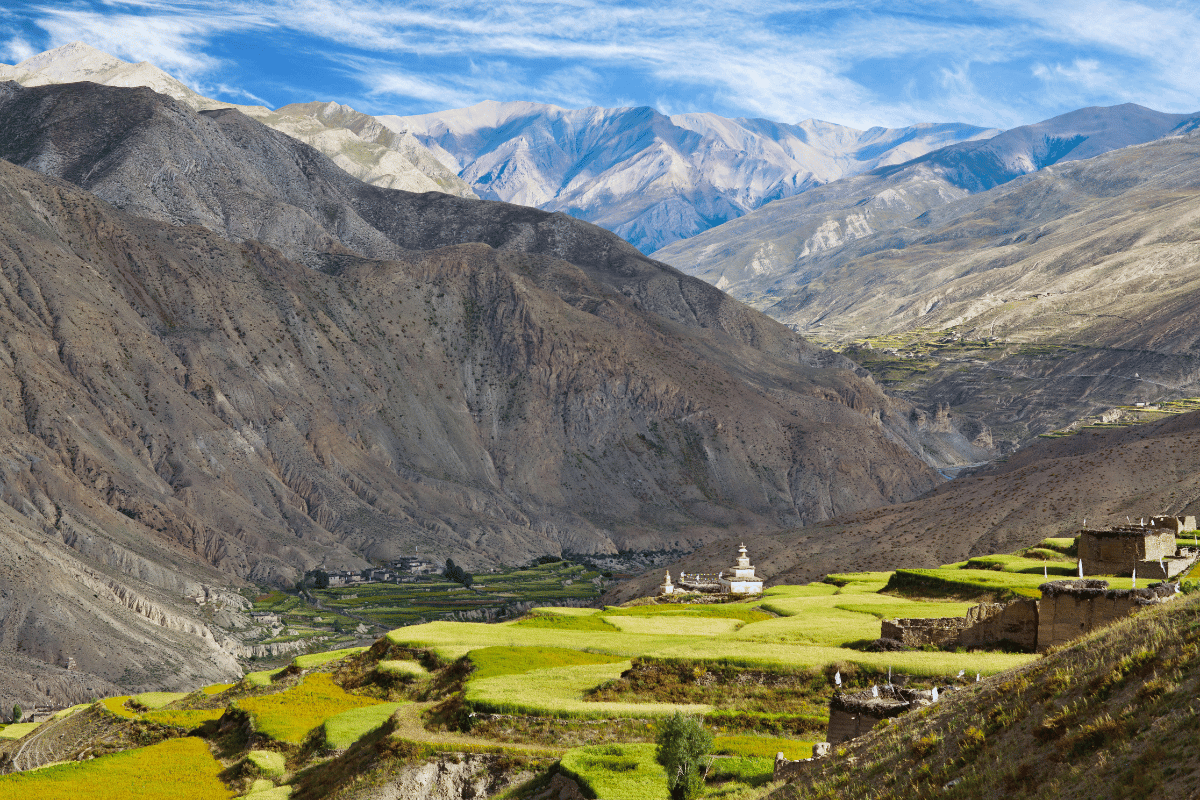
Besides the natural wonder, Saldang also houses numerous religious monasteries and gompas featuring ancient sculptures and murals showcasing their unique religion and beauty. The Gonpa/Gompas of Dolpo, including the revered Samye Choleing and Margom Yetshe, form the spiritual backbone of the region, preserving the ancient traditions and customs that have defined the local way of life for ages. The sacred monasteries have kept the fame of Tibetan Buddhism burning bright, ensuring the continuity of a rich cultural heritage that remains an important part of Dolpo’s identity.
Other Well-known Villages
Each village in Dolpo boasts its own unique character, shaped by its distinct natural surroundings, spiritual importance, and geographical settings. Situated in the rugged Himalayan landscape, every village has evolved in harmony with its environment, creating a diverse tapestry of culture. Tradition and jaw-dropping scenery set each one apart from the others. Beyond the village mentioned, Dolpo is home to several other settlements, each with its own importance and significance to the local community. Located throughout the region, these villages may be lesser-known, but they are no less important to the cultural fabric and daily lives of the locals who call Dolpa/Dolpo home, contributing to its rich tapestry of traditions, customs, and ways of life that define this enchanting isolated region.
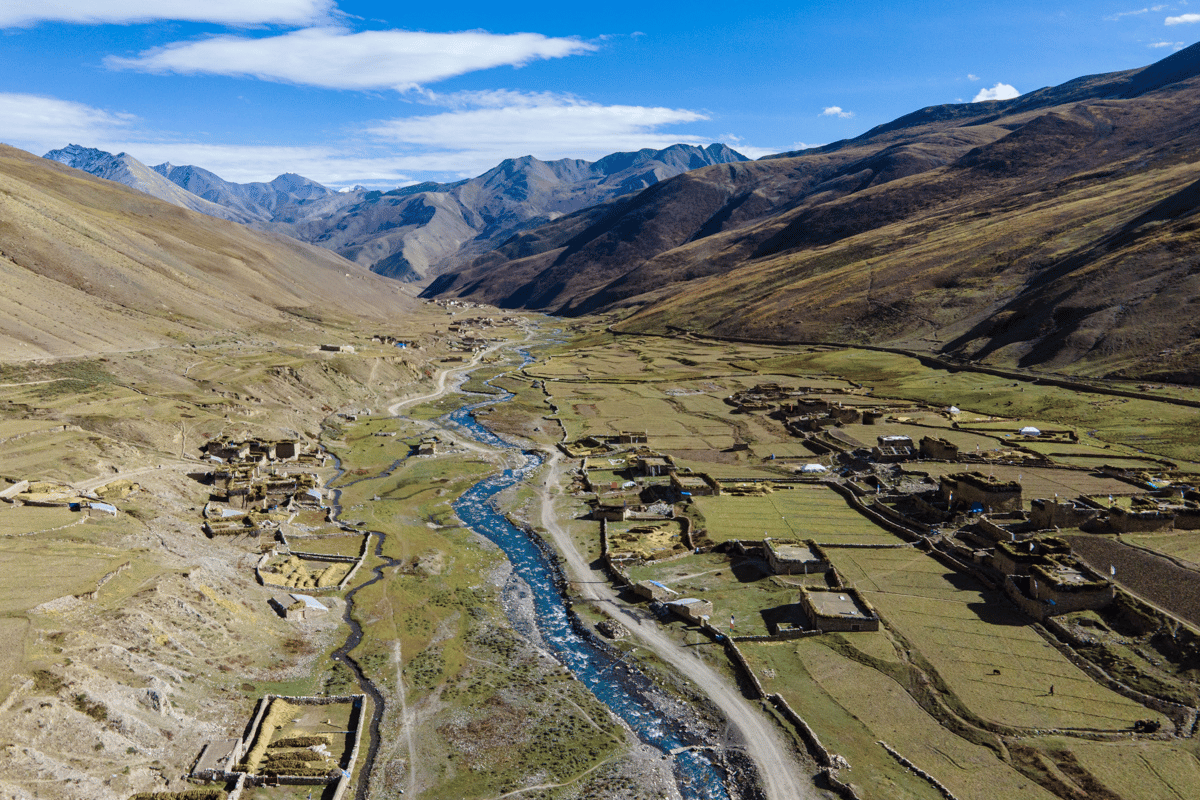
Some other villages, such as Musigaon, which is also the last village on the north side of Dolpo at a staggering height of 4,826 meters. The trail to Musigaon is rugged and from here one can get close to the Tibetan border and explore the surrounding area. Musigaon shares a boundary with the Tibetan Plateau. The people of Dolpo travel from Musigaon to trade in Tibet. As these villages are close to the Tibetan borders, one can see the seamless influence of the Tibetan culture here alongside the ancient Bon culture. In addition to their distinct locations, they have similar cultures, architectural styles, and welcoming locals.
There are numerous other villages, such as Shimengaon, Tinjegaon, Chharka Bhot, Tokyu, and others, all across the Dolpo region that are as unique as they sound. These villages are surrounded by fields covered in seasonal crops with breathtaking backdrops of the mountains. As these villages are mostly located in the valleys, you will get to see the unique landscape of the places along with their spectacular flora and fauna, which just adds to the experience you will get in these villages. The architecture of these places represents the ancient culture, practices, and simple beauty that is hardly found anywhere else, making your journey or stay even more fascinating. These celestial villages give an insight into the local people's day-to-day life and their traditions and culture.
Conclusion
These picturesque villages are a testament to the region’s rich cultural heritage and splendid natural beauty. From the ancient monasteries/gompas to the rustic charm of traditional villages, each village offers a unique glimpse into daily life that has remained mostly unchanged through the centuries. As you explore the settlements of Dolpo, you will be reminded of the importance of preserving these fragile communities and the land they inhabit, so the future generation can continue to marvel and live the traditions of the past. The beauty and resilience of these incredible regions speak courage and resilience to today’s modern world, which is stuck between a concrete jungle and a brutal internet world. These villages are reminders for us to slow down, relax for a moment, and soak in what nature has to offer.
Frequently Asked Questions (FAQs)
Here are some of the most frequently asked questions about villages in Dolpo:
Are there any lodging facilities in these villages?
Since Dolpo is an isolated area, the lodging facilities and facilities in general are minimal. Most of the villages are not commercialized and do not provide facilities such as lodging and food however, in a few villages, such as Ringmo and Dho, you can find local tea houses where you can experience the local hospitality, which provides you with the basic food and bedding facilities. If you plan to travel you must be prepared, as most of the places require camping as the villages are located far from each other.
Are there any transportation facilities in these villages?
Unfortunately, no. There aren’t any transportation facilities to most of the village, as most of the area is still in developing phases. The whole Dolpo region is accessible by its only operating airport, which is the Juphal Airport in Juphal, after which visitors have to trek to reach any of the villages in the Dolpo region. Some of the villages, like Dho, Ringmo, and Saldang, are accessible by helicopter, but the beauty of the region is best experienced by trek. However, in some parts of the upper Dolpo region, one can take advantage of motorbikes from village to village used by the locals imported from Tibetan borders.
Are there any healthcare facilities in any of these villages?
While major villages like Ringmo and Dho Tarap have some basic healthcare facilities, the Dolpo region is still remote, and medical facilities are scarce. In many villages, locals still rely on traditional doctors called ‘’Amchies’’ who use ancient techniques and locally collected herbs to treat illness. If you are planning to visit, you must be prepared as there is not much help you can expect.
What kind of cultural exposure will I get in these local villages?
Dolpo is a hotpot of different cultures, religions, and traditions in the lower parts, but as you move to the Upper Dolpo, the majority of people follow Buddhism and Bon religion. Bon religion is an ancient religion that is followed in Dolpo in its purest form. In the Upper Dolpo region, one can witness the pristine Bon religion and Tibetan Buddhism at their best. The traditions and customs reflect on the locals day-to-day lives, from their clothing to the way they carry out their daily chores.
What are these villages popular for?
These villages in Dolpo are widely known for their landscape, traditions, and simple way of life. These villages are in the highlands of the Himalayas with minimum or near-no facilities. The small paradise of the arid landscape of Dolpo is unique in the lush country of Nepal. Traveling to Dolpo is like no other. It is like going back in time.
How can I get to these villages?
There are various ways to get to these villages; among those, the most popular one is to fly to the Juphal Airport in Dolpo and then start your trek towards the villages in Dolpo. You can also opt to go to Jomsom by airplane and then start walking to enter the Dolpo region with its beautiful highland settlements.
Are there any special festivals or events celebrated in these villages?
The people in these villages celebrate various festivals like Losar, Shey festival, Chaite, Yungney, etc. Among these festivals, the Shey festival is widely known because it is celebrated every 12 years in a row, in the year of Dragon. The Shey festival is celebrated in the Shey Gompa. People travel from various places, inside and outside Dolpo for the Shey festival. The most recent Shey festival was in 2024 AD and the next Shey festival will be in 2036 AD.
What kind of permits or paperwork do I need to visit these villages?
Visiting these villages or to put it simply, trekking in the Dolpo region, requires permits. One would need a TIMS Card (Trekking Information Management System Card), a Shey Phoksundo National Park Permit and a Restricted Area Permit (Upper and Lower), which depends on your itinerary.
Is reaching these villages easy?
As these settlements are located in different parts of Dolpo at 3000–4000 m above elevation, accessing these places will be challenging to your mental and physical fitness. Reaching these villages requires crossing high mountain passes and walking through the demanding landscape of Dolpo. However, these villages are worth every step you take, as the celestial view and warm hospitality of the locals will make you feel at home.

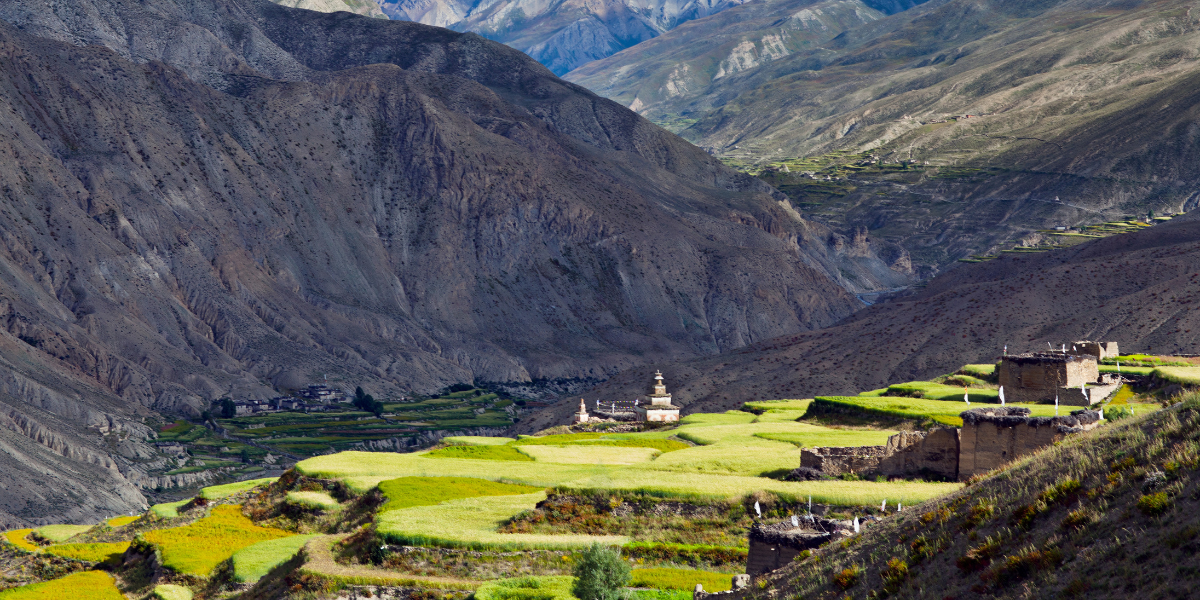
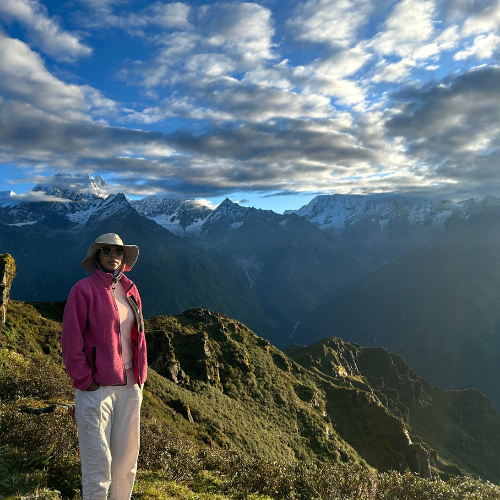 Kriti Maharjan
Kriti Maharjan
